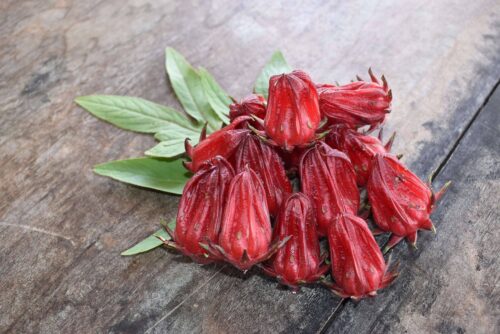Explore the 13 Amazing Roselle Plant Benefits and Uses for rich flavor and numerous health advantages in this comprehensive guide.
This beautiful plant is not just loved for bold-colored fruits and charming leaves, but Roselle Plant Benefits and Uses are also amazing. You will also learn about the herbal tea recipe of Hibiscus Sabdariffa in this article.
Read: Tips to Grow Insulin Plant
What is Hibiscus Sabdariffa?

Roselle (Hibiscus sabdariffa) is a shrub from the Malvaceae family; it is native to Africa and Caribbean countries like the West Indies, Trinidad, and Tobago. People now widely cultivate Roselle in tropical and subtropical regions worldwide, particularly in India and Southeast Asia, under the common name of Red Sorrel or sour tea in Iran. For centuries, people have used Roselle for therapeutic purposes, such as using its juice extracted from leaves to treat conjunctivitis in Senegal or using pulverized foliage to soothe sores and ulcers.
Farmers primarily grow Roselle for bast fiber extraction obtained from the stem, which is a substitute for jute. At the same time, Hibiscus cannabinus is commonly grown in southern Asia for fiber extraction purposes.
Roselle is an easy-to-grow shrub that can reach impressive heights and is identifiable by its bright red stems and unique flowers. It produces a calyx at every node, which is an essential ingredient used in food preparation, both in its fresh and dried form.
Read: Fuyu Persimmon Benefits
Roselle Recipes
1. Roselle Juice Recipe
Ingredients:
- 10-12 Roselle calyx
- 6 cups of water
- 1/4 cup of Sugar (adjust as per taste)
Directions:
- Use a knife to remove seeds from the calyx.
- Rinse the calyx to eliminate any dirt present.
- Heat water in a large saucepan on medium heat and add sugar to it.
- Add the Roselle calyx to the mixture and let it boil for 8-10 minutes.
- Use a strainer to remove the calyx and discard it.
- Serve the Roselle juice, either hot or chilled, and enjoy!
Note: It has been found in this report that the consumption of a typical amount of Roselle is generally considered to be safe for most people.
2. Roselle Leaf Salad
For those who want to liven up their salads with a unique flavor, the leaves of the Roselle plant may be worth considering. These leaves offer a taste similar to peppery spinach, with a hint of sour fruitiness that appeals to many. It’s no wonder that the Roselle leaf is a popular addition to salads.
3. Roselle Flower Tea and Candies
The flowers of the Roselle plant can be a great addition to tea blends or used to make tea, whether they are fresh or dried. In India, they are known as Lal Ambari or Patwa and are valued for their tart flavor and numerous health benefits. They are even used by some people to add flavor to candies.
Read: Houttuynia Cordata Benefits
Roselle Plant Benefits and Medicinal Uses

1. Anti-inflammatory and Antibacterial Properties
The high ascorbic acid content in Roselle tea, also known as vitamin C, makes it an essential nutrient that stimulates and enhances the immune system’s activity. Fresh or dried roselle flowers have significant quantities of Vitamin C, which may offer the following benefits:
- Boosting the immune system to prevent colds and flu
- Anti-inflammatory and antibacterial properties
- Providing relief for the discomfort caused by fever due to its cooling effect.
2. Menstrual Pain
For women, drinking Hibiscus Sabdariffa tea may aid in alleviating cramps and menstrual pain while also restoring hormonal balance. This can result in a reduction of other menstrual symptoms such as mood swings, depression, and overeating.
3. Weight Loss
Roselle tea is believed to have potential benefits for weight loss. Consuming carbohydrate-rich foods can lead to weight gain as they contain sugar and starch. However, according to a few researchers, hibiscus extract can help reduce the absorption of glucose and starch, thus aiding in weight loss.
This tea inhibits the production of amylase, an enzyme that helps in carbohydrate and starch absorption, making it effective in preventing their absorption. As a result, hibiscus tea is commonly used in weight loss products.
4. Improve Digestion
The tonic and diuretic qualities of the seed capsule of the Roselle fruit make it useful for several purposes.
- It increases urination and bowel movements, acts as a natural diuretic, and helps treat constipation.
- Additionally, some studies suggest that the seed capsule may protect against colorectal cancer.
5. Anti-Cancer Properties
Hibiscus sabdariffa tea is rich in protocatechuic acid, which possesses antioxidant and antibacterial effects. Studies suggest that consuming hibiscus tea may lead to the induction of apoptosis or programmed cell death, thereby slowing down the growth of cancerous cells.
6. Good For Kidney Health
According to this research on mice, it has been reported that, when administered at a dosage of 3.5 mg per day, roselle extract demonstrated the ability to decrease calcium oxalate crystal buildup in the kidneys of mice with induced hyperoxaluria by glycolate. Additionally, it led to a rise in urinary calcium excretion while keeping serum calcium levels unchanged.
7. Antidepressant Properties
Flavonoids present in the roselle plant are known to possess antidepressant properties and can aid in calming the nervous system. They can create a sense of relaxation in both the body and mind, which may help to alleviate symptoms of anxiety and depression.
8. Boost Immunity
Due to its anti-inflammatory and mild anti-bacterial properties, roselle is recognized for its potential to alleviate coughs and colds. Hibiscus sabdariffa tea is often used as a natural supplement for treating these ailments. Its cooling effect can also relieve the discomfort of fevers commonly associated with these illnesses.
9. Protects Liver
The antioxidant properties of certain compounds in the roselle plant may help treat liver diseases. Antioxidants can protect the body from various illnesses by neutralizing free radicals in body tissues and cells, which can contribute to developing diseases.
10. Good for Blood Pressure
According to this research on 390 participants, the significant effects of Hibiscus sabdariffa were found to lower SBP (Systolic blood pressure) and DBP (diastolic blood pressure). Still, more trials are essential to confirm these results.
11. Healthy Pregnancy
Roselle plants contain a good amount of iron, which leads to a healthy pregnancy.
Note: Consult your gynecologist before consuming the roselle plant in any form.
12. Good for Teeth and Gums
Roselle plants are great for your oral health as they are rich in calcium.
13. Improve Skin
It contains Anthocyanin and polyphenols, specifically Protocatechuic Acid, which is present in Roselle Juice and possesses antioxidant properties. These compounds help in preventing cancer, slow down the aging process, and promote the relaxation of blood vessels.
Read: Malabar Spinach Benefits
Disclaimer
It is recommended to approach the use of the Roselle plant for medicinal purposes with caution as its benefits on health are still under study. If you have a medical condition or are taking medications, consulting with a physician before using any herbal supplement is advised.
Roselle Plant Uses
Roselle Plant has many uses, as all its parts can be used for various purposes. For example, the calyces, leaves, stems, and flowers of Roselle can all serve different functions. The many uses of Roselle include:
Food
The roselle plant offers an exciting flavor that can be enjoyed in various ways. People commonly use fresh calyces to create a delicious and brightly-colored drink, known as roselle juice or flor de jamaica.
Additionally, the plant’s leaves sometimes appear in salads, providing a tangy and slightly spicy taste similar to that of spinach mixed with sour fruit. Furthermore, various recipes call for the dried calyces and flowers of the roselle plant as key ingredients.
Skincare
The beauty and skincare industry widely recognizes the benefits and uses of the Roselle plant for its anti-aging properties. Its flowers are particularly popular in various beauty treatments, including face and body scrubs, facial steams, and clay masks.
This is because the roselle flowers contain antioxidants that effectively counteract the harmful effects of free radicals, promoting a healthy and youthful appearance.
Decoration
The Roselle plant’s vibrant red flowers are primarily chosen by plant enthusiasts for both decorative and medicinal purposes, making it a popular choice for floral arrangements.
Additionally, the fresh calyces of the plant can add a distinctive and eye-catching element to any floral arrangement.
FAQs
Q.1. Can Roselle be used as a natural hair treatment?
Yes, Roselle can be used as a natural hair treatment due to its enriching properties. The plant contains vitamins and minerals that help nourish the hair and scalp, promoting healthy hair growth and strengthening the hair shafts. Roselle-infused hair rinses or herbal hair masks can be used to condition the hair, add shine, and soothe the scalp. Additionally, the natural red color of Roselle can also act as a hair dye or highlighter for those seeking a temporary and natural alternative to chemical hair dyes. As with any new hair treatment, a patch test is recommended to ensure no allergic reactions occur.
Q.2. Can Roselle be used to make natural dyes?
Yes, Roselle calyces can be used to produce natural dyes. The deep red color of the calyces can be extracted and used to dye fabrics, yarns, and other materials. This natural dyeing process is eco-friendly and produces attractive, reddish hues.



